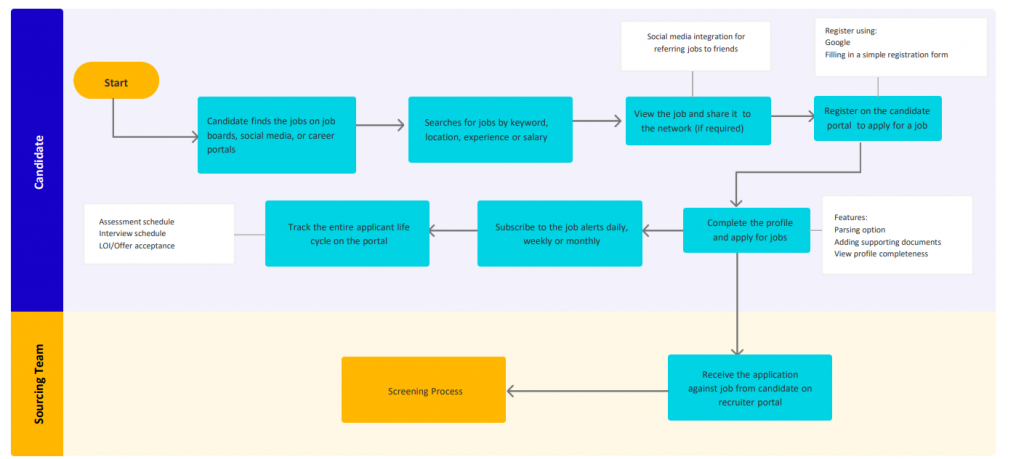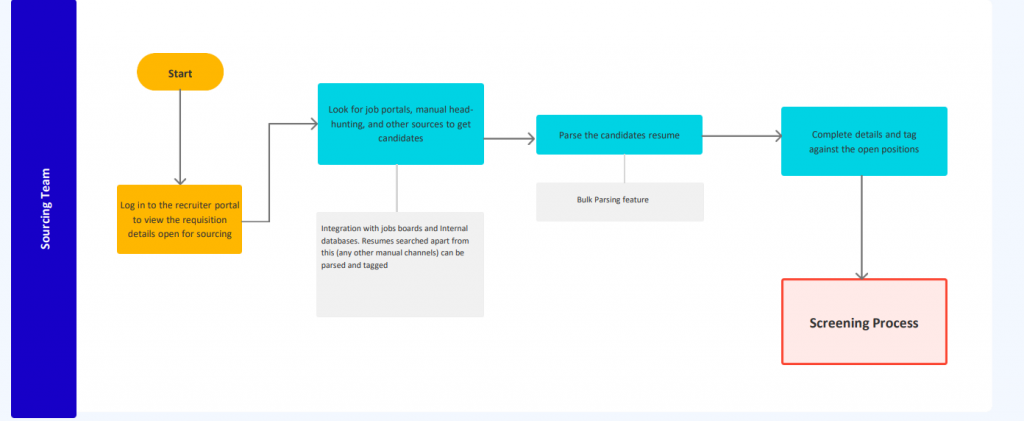After the tremors of the Great Resignation, a sense of stability is setting into the global recruitment arena.
The EMEA (Europe, the Middle East, and Africa) region has caught up with the Asia-Pacific (APAC) region to tie for the position of the fastest-growing region for domestic and global recruitments.
Notably, there’s been a whopping 52% decrease in involuntary terminations while salaries and job demands stay flat, or even increase in some cases. Perhaps most notably, global remote hiring is flourishing (Source).
This period of stability is the harbinger of a golden opportunity for businesses that can refine their recruitment process to capitalize on such favorable hiring trends. This is your practical and actionable guide for an efficient recruitment strategy.
Suggested Read:
The Ultimate Recruitment Process Guide
Identifying Challenges in the Existing Recruitment Process
Before learning how to streamline the recruitment process, one needs to understand the unique challenges that dot this journey. Here’s an overview of the various challenges across the different stages of the hiring process:
Challenges in the Awareness Stage of the Recruitment Process
Here are some challenges that businesses face while attracting qualified talent from the target region:
- Language barriers: Job descriptions, keywords, and branding material may not resonate with the ideal candidates if not localized to match the target region’s language and culture.
- Limited reach: Identifying the right job posting board for different regions and optimizing the job description for each is time-consuming. However, failure to do this can cause you to miss out on top talents.
- Understanding local trends: Trends are not universal. For instance, although APAC is one of the largest recruiters, countries like Singapore, India, and Indonesia have registered a decline in hiring rates.
Challenges in the Sourcing Stage of the Recruitment Process

While identifying a pool of qualified candidates possessing the desired skills and experience, you can expect the following setbacks during talent acquisition:
- Data privacy regulations: Data protection regulations like the GDPR in the EU or the CCPA in California restrict access to candidate information. Plus, you must streamline the recruitment process to adhere to these laws and regulations.
- Varying resume formats: The lack of standardization in resume formats and the diversity of presenting candidate information in different regions make resume evaluation trickier.
- Lack of internal resources: Recruiting teams and hiring managers may not possess the experience or have access to recruitment tools or resources like an applicant tracking system (ATS) for sourcing talent from different countries.
Challenges in the Screening and Assessment Stage of the Recruitment Process

The screening and assessment of candidates to gauge whether they are fit for the role presents the following challenges:
- Limitations of standardized testing: A test designed for a specific region may not translate faithfully for another region owing to cultural differences, talent pool variation, and knowledge base.
- Bias in assessments: Unconscious or human bias, even in AI and cognitive computing models, can creep into the screening and assessment process if not monitored carefully.
Suggested Read:
A Complete Guide to Recruitment Screening Process
Challenges in the Interviewing Stage of the Recruitment Process

Interviews, whether virtual or in-person, are plagued with the following issues:
- Language barriers: Language barriers can impair communication and hinder evaluation, giving rise to misunderstandings. Language barriers make it difficult to assess technical skills, soft skills, and cultural fit.
- Time zone difference: Scheduling interviews is rather complex by itself. However, doing so across time zones while ensuring the availability of the candidate, hiring managers, and interview panel members is tougher!
- Differing non-verbal communication: Cultural influence in communication styles and body language could impact interviews. For instance, the communication style and body language in North America are more direct, assertive, and to the point. In contrast, the same is more indirect, nuanced, and focused on politeness in South-East Asian cultures.
Challenges in the Offer and Onboarding Stage of the Recruitment Process

You can expect bumps while negotiating terms and onboarding a new hire into the company due to the following challenges:
- Differing compensation and benefits expectations: Salary structures, vacation policies, employee policies, and other benefits vary greatly across regions. The local labor laws also influence these parameters.
- Complexities with visa and relocation: In case the candidate has to relocate for the job, you may have to aid them in navigating the logistics of arranging a visa, facilitating the move, and compensation for it.
- Establishing relationships with remote teams: Integrating a new hire into a team can be challenging, more so if your team operates remotely. A lack of sense of belonging or community can easily disengage the new hire and hamper productivity.
13 Strategies to Streamline the Recruitment Process
Keeping in view the challenges listed above, the following strategies can help you streamline the recruitment process:
- Draft a clear job description focusing on the skills and competencies attached to the role rather than educational qualification or number of years of experience. Such an approach to crafting the job listing will offer flexibility to qualified candidates possessing transferable skills from different backgrounds.
- Showcase your company culture and employee value proposition (EVP) – not just in the job description but across online spaces. The objective is to establish employer branding for global audiences to expand talent outreach while landing a candidate who is a cultural fit.
- Tap into online communities and forums relevant to the position to target talent pools with unrealized potential. Also, use professional networking platforms like LinkedIn, Indeed, etc. to identify passive job hunters.
- Host and attend online and in-person events. Individuals who enroll for these trade shows, industry events, webinars, seminars, workshops, career fairs, etc. are actively working toward skill and capacity building which makes them a good hire.
- Leverage employee testimonials to communicate positive employee experiences (EX). Seeing how EVP and EX are slated to be the new competitive differentiators, promote these on your website, socials, and other platforms.
- Run employee referral programs to incentivize current employees to refer qualified candidates from their networks. Similarly, prioritize internal talent mobilization to nurture in-house talent.
- In addition to ATS for managing applications and automating tasks, investing in additional recruitment technologies such as PeopleStrong is crucial. These innovative recruitment systems harness cutting-edge technologies like AI to perform end-to-end hiring – from sourcing to onboarding.
- Identify gaps in your recruitment tech stack and supplement these with appropriate solutions. Look for options that offer a user-friendly interface, video conferencing tools, translation capabilities, scheduling tools, etc. to facilitate virtual recruitment.
- Conduct multi-stage screening and assessments to vet candidates comprehensively. Engage local hiring managers and maintain multiple testing and screening windows to account for any cultural and time zone variations.
- Standardize and document the recruitment process using tools like checklists for greater consistency. Indicate the different stages, timelines, responsibilities, etc. throughout the cycle to maintain accountability and ownership.
- Maintain a record of potential candidates who have cleared the screening or interview stages but have not been recruited for various reasons. Nurture relationships with them by informing them about any upcoming career opportunities, company updates, and other news.
- Develop candidate feedback surveys that capture candidate sentiment across the various stages of recruitment. Keep it brief and focus on the experience, clarity of communication, and overall value proposition.
- Conduct exit interviews with employees leaving your organization to identify the areas of improvement in your work culture and EVP. Analyze, prioritize, and act on the feedback.
Conclusion
To sum up, the global recruitment landscape is favorably poised for businesses willing to adapt to the market trends.
While issues like language barriers, local and cultural influence, and legal and regulatory variations are fairly common in global hiring processes, they’re all surmountable. It is simply a matter of pivoting recruitment strategies and innovating through technology to overcome challenges and keep up with the changes.
However, such an endeavor begins with a robust digital infrastructure. PeopleStrong’s recruitment software can be such a foundation for global businesses. In building the workforce of the future, we’ve partnered with leading companies worldwide to acquire, hire, and onboard top talents. We’ve delivered proven results with our global clientele, allowing for rich insights into the challenges and opportunities of attracting talent in today’s competitive markets.
FAQs
How do you ensure legal compliance in global recruitment?
Ensuring legal compliance in global recruitment requires a comprehensive strategy that spans researching local labor laws and data privacy regulations prevalent in each region. Consider consulting with a legal practitioner or counsel or partnering with an established recruitment agency experienced in international hiring.
How to measure the success of the recruitment process?
Measuring the performance of a recruitment process is crucial to embrace the principles of continuous learning and improvement. You can assess this using metrics like:
- Time to Fill
- Time to Hire
- Source of Hire
- Quality of Hire
- Candidate Satisfaction
- Cost per Hire
- Application Complete Rate
- Offer Acceptance Rate
- Diversity Metrics












